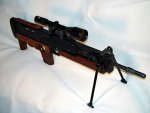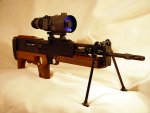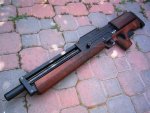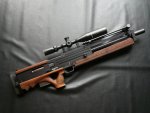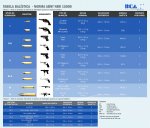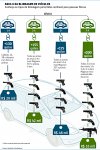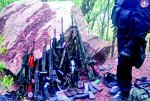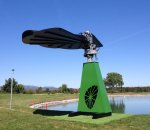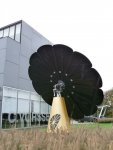Hi
Luke,
It's called the "Blaster", and was first sold in South Africa in the late 1990's -- see
[video=youtube;fDrzMGdYWZc]https://www.youtube.com/watch?v=fDrzMGdYWZc [/video] [video=youtube;LQbHnLSasfQ]https://www.youtube.com/watch?v=LQbHnLSasfQ [/video]
The "Blaster" never became illegal in South Africa, but it did not prove very popular, even though South Africa has the highest (or one of the highest) rates of car-jacking per-capita in the world -- see
https://en.wikipedia.org/wiki/Blaster_(flamethrower) ,
http://news.bbc.co.uk/2/hi/africa/232777.stm ,
http://edition.cnn.com/WORLD/africa/9812/11/flame.thrower.car/ ,
http://www.wsj.com/articles/SB91601019351200500 ,
http://www.sfgate.com/news/article/CLJ-Flamethrower-Is-Hottest-Defense-Against-2948892.php , and
http://blog.beforward.jp/car-review/remember-bmw-blaster-south-africas-flamethrowing-car.html .
***********************************************
1. Designing as a Buddhist pacifist, for merely "passive" protection
***********************************************
As far as I know, antipersonnel flame-throwers are illegal in most countries. Reputable companies like Texas Armoring refuse to install such devices:
Can you install guns, tear gas, flame throwers,etc?
We are in the business of saving lives and as such we do not offer potentially lethal options. Tear gas (along with other similar chemicals and weapons) has been placed under strict government regulation and is not offered as an option on our vehicles.
See
http://www.texasarmoring.com/texas_armoring_faq.html .
Like Texas Armoring, I would want the TerraLiner to have only "passive" self-defense protection, and such protection would only be needed when the TerraLiner is underway, traveling from campsite A on protected farmland, to campsite B on protected farmland. Remember, although I know a great deal about guns, and did a lot of hunting when I was a kid, because of an NDE (Near Death Experience) I am now very much a hippie-dippie idealist and pacifist -- see
https://en.wikipedia.org/wiki/Near-death_experience . I am the kind of idealistic globalist who unashamedly loves the Coke song:
See posts #2228 and # 2229 at
http://www.expeditionportal.com/for...w-6x6-Hybrid-Drivetrain?p=1990958#post1990958 . So the very last thing I would want the TerraLiner to do is blast mixed-race or Black car-jackers with a flamethrower!! I am also a Euro-socialist (as per Germany's SPD), and I am not an American neo-Victorian Republican -- see
https://en.wikipedia.org/wiki/Social_Democratic_Party_of_Germany . So I do not blame the poor for their poverty, and I tend to see a very strong sociological link between poverty, economic inequality, and crime.
The idea behind camping on farmland is that it provides inherent security. It is a "sociological" solution to the problem of TerraLiner security, as opposed to a technological solution, or a
"burn the bastards" solution. Brazil is full of organic farms that supplement their incomes by also functioning as eco-lodges or eco-camps. And of course Brazil is full of lots of more regular farms, too. I am reasonably convinced that a vehicle like the TerraLiner, which will have the ability to drive into and out of any plot of land that a farmer is willing to rent, could find plenty of security, protection, and relative invisibility simply by seeking out farms to camp on. The TerraLiner will be relatively autonomous from a sewage, power, and water point of view, it won't need the traditional hook-ups provided by paved pitches in RV parks, so camping on farmland will be a real option. Aesthetically speaking it will also be a vastly superior option, because RV parks do not strike me as all that attractive. No RV brochures ever depict motorhomes camping beside hundreds of other motorhomes, even though that's the reality of the Class-A RV lifestyle. Rather, RV brochures depict motorhomes in the middle of nowhere, camping "in nature" with no other motorhome in sight. As such, RV brochures are selling just a fantasy, and they are visually lying. Conventional RVs do not have this capability, because they are not autonomous enough, and they do not have the frames or the wheels necessary to drive into and out of farmland.
***********************************************
2. Should the TerraLiner's exterior be deliberately designed to look ugly, or threatening?
***********************************************
There is also another possible "solution" to the problem of TerraLiner security, and that's to make the TerraLiner as ugly as possible on the outside, so that even when camping, it looks like a garbage truck that nobody would want to attack. This is more or less the de-facto solution that ActionMobil, UniCat, etc. have arrived at. Their expedition motorhomes look like ugly garbage trucks, and perhaps deliberately so. They probably have no interest in developing more aesthetically and functionally satisfying vehicle exteriors, i.e. vehicles with large drop-down decks like the Paradise Motorhome, decks that when unfolded while camping will reveal large windows. Because then, as
egn has suggested, the vehicle might become a more attractive target.
For a designer this is of course a complete non-starter. Imagine being an architect, and clients asking one to design the exterior of their house to be as ugly as possible, so that nobody will want to burglar it. The whole design exercise becomes absurd and pointless, because no designer wants to deliberately design something to look ugly. But in effect that's what a number of thread participants have been suggesting that I should do as regards the exterior of the TerraLiner.
For instance, one thread participant suggested that the TerraLiner should take as its model FPB boats, which have exteriors (it is claimed) that resemble military-style PT boats -- see
http://www.setsail.com ,
https://en.wikipedia.org/wiki/PT_boat ,
https://www.youtube.com/watch?v=iTuyA84QXKs ,
https://www.youtube.com/watch?v=sx3i9lQnQlU , and
https://www.youtube.com/watch?v=FtMJFROT2zk :
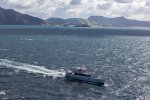
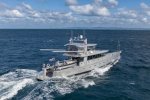




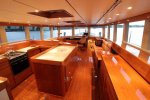
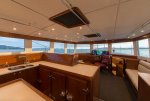

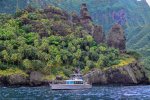
Actually, these boats have so much glass, and they are so sleek and elegant, that claiming that potential attackers will leave them alone because they look military strikes me as total nonsense. Sure, they don't have the typical appearance of a luxury power yacht, with a hull painted white, teak decks, etc. But they don't exactly look military either, especially the more recent models, which are becoming larger, more luxurious, and even more elegantly designed on the outside as well as the inside. I think FPB boats are really quite beautiful, and if I were a coastal pirate, their appearance alone would not deter me from attacking them. They look luxurious and beautiful almost
because of the minimalistic elegance of their unpainted aluminum hulls; their very sleek, rakish lines; their windows canted back to disperse water quickly, etc. They look like the large-power-yacht equivalent of Ferraris. So as a pirate their appearance would make me want to attack them more, not less.....:sombrero:
If anything, learning about FPB boats and surfing its website extensively (I've been all over it for the last year), has inspired me to be more aesthetically courageous in my design thinking, not less. FPB boats really thought through the program, the specific application. They began with a blank slate, throwing out all prior expectations as to what a world-travellling power yacht "should" look like. The final design they came up with looks vaguely like a PT boat, but more like a weird cross between a PT boat, a fishing trawler, and a sport-fishing vessel of the kind that has large outriggers for trolling, a flybridge, and often a conning tower reached by a ladder -- see
https://en.wikipedia.org/wiki/PT_boat ,
https://en.wikipedia.org/wiki/Fishing_trawler ,
https://en.wikipedia.org/wiki/Sport_fishing_boat ,
https://en.wikipedia.org/wiki/Flying_bridge ,
https://en.wikipedia.org/wiki/Conning_tower ,
https://www.youtube.com/watch?v=2-HkGr916xY ,
https://www.youtube.com/watch?v=6z9IoQu-zOo ,
https://www.youtube.com/watch?v=OD9sIBLF8h0 ,
https://www.youtube.com/watch?v=yaMQXHF0LVA ,
https://www.youtube.com/watch?v=DqxAcPh8_hE , and
https://www.youtube.com/watch?v=0niwFfwgzsQ .
The final design of the FPB is incredibly original as well as highly practical, in the sense that it addresses the requirements of the stated program perfectly. It is also stunning, a Ferrari on water, and much more beautiful than most of the power yachts that I've seen. But would coastal pirates mis-identify an FPB boat as a military threat? Somehow, I just don't think so.....:ylsmoke:
There is another important point to be made here. In the past, some thread participants have subscribed to the macho-masculine illusion that if a vehicle looks threatening and militaresque, then this alone will somehow deter potential attackers. The idea here is that if the exterior of the vehicle is rectilinear, very "butch" and "macho", then it will function visually as a threat-display. It will somehow say to would-be burglars or car-jackers, "Beware!!" The reasoning here is very masculine, something to the effect that "the best defense is a good offense". Make the first threat-display in a male pissing contest, and car-jackers will leave one's vehicle alone. But honestly, anyone who attacks a car, truck, or motorhome with a gun, is so desperate and aggressive, that what a vehicle looks like will probably make no difference to them.
A very macho-looking vehicle exterior might give the
owners a false sense of safety, security, and invulnerability. But I figure that the psychological effect on potential car-jackers will be nil.
Think of it this way. Do bus-designers go out of their way to make bus-exteriors look ugly? Even in Latin America? Just like European roads, South American roads are full of beautiful long-distance buses designed by MAN, Setra, Volvo, Scania, and home-grown Latin American manufacturers:
Those who designed such buses did not think,
"Hey, we should make their exteriors as ugly as possible, so that car-jackers will not try to stop them, and rob the passengers." In Latin America such buses do get "bus-jacked", with passengers expected to hand over all their cash and valuables at gunpoint. But even still, this has not motivated anyone to come up with an ugly looking bus to deter bus-jacking. Instead, their well-designed exteriors will continue to look like the well-designed exteriors of all other buses, so at the very least they won't be singled out. Along similar lines, I figure that if the TerraLiner merely looks like a rather advanced sort of aerodynamic truck pulling a drawbar trailer behind it, then that should suffice. Contemporary truck cab-designs are becoming ever more aerodynamic with low drag coefficients, which means they are becoming ever more curvilinear, sleek, and beautiful. So I don't see why the TerraLiner should look any different.
Put succinctly, the problem is not looking beautiful on the outside. Rather, the problem is looking different. Anything that suggests to a carjacker that one's vehicle might be a particularly lucrative target, decreases one's safety. But all contemporary long-haul buses look very beautiful on the outside, so it's impossible for a bus-jacker to decide which one will yield the most cash, based on exterior appearance alone.
Now here is something that some of the more military-minded thread-particpants have failed to consider. Looking different also
includes looking more butch, aggressive, and militaresque on the exterior.
Consider: Texas Armoring deliberately conceals its armoring. Texas Amoring takes very ordinary-looking SUVs, and after the armoring process, they still look like very ordinary SUVs. They don't look any more aggressive or threatening on the outside after they have been fully armored. All the armoring is concealed, because if it were not concealed, and if it were obvious that an SUV is very heavily armored and not typical at all, that mere fact alone might make the SUV and/or its owners a more attractive target. Designing to create a militaresque sort of threat display, is actually kind of male-macho-stupid, because it very loudly advertises to the outside world, "I am worried about my safety". That alone makes potential car-jackers wonder, "Heh, if those people in that vehicle are worried about their safety, then they must be worth attacking." In other words, an aggressive-looking vehicle exterior actually invites aggressive interest. Whereas if one's armored SUV looks exactly the same on the outside as all other SUVs, then one is not advertising oneself as a particularly worthwhile target.
This may not seem obvious, and it may be difficult to understand, but from a military and biological point of view, what Texas Armoring is doing would be classified as "
mimetic camouflage" -- see
https://en.wikipedia.org/wiki/Camouflage :
Camouflage is the use of any combination of materials, coloration, or illumination for concealment, either by making animals or objects hard to see (crypsis), or by disguising them as something else (mimesis).
Texas Armoring is in effect disguising very armored vehicles to look like ordinary SUVs. Texas Armouring is using "mimetic camouflage" to provide protection for its customers.
Needless to say, this a far more sophisticated way to think about how to design for TerraLiner security, than designing for ugliness, or designing to create a militaresque threat-display. In the case of beautiful long-haul buses, the disguise is the fact that most contemporary long-haul buses now have very beautiful exteriors. Again, mimesis: one beautiful bus exterior looks about as good as the next beautiful bus exterior. And in the case of the TerraLiner, the disguise or camouflage will be the TerraLiner's resemblance to a rather advanced, aerodynamic, 3-axle truck that's towing a drawbar trailer. Nowadays such vehicles can have very beautiful exteriors, so the TerraLiner could have a very beautiful exterior, too. Just as long as it is disguised or camouflaged as a truck, pulling a trailer.
Finally, in this section we should note that the one big exception amongst expedition motorhome manufacturers is Earthoamer -- see
http://earthroamer.com . Earthroamer expedition vehicles are extremely beautiful on the outside as well as the inside. On the outside their camper bodies are single-piece composite shells that have rounded corners, and the whole ensemble is about as elegant and breathtaking as it's possible for a truck-camper to be:
[video=vimeo;118072292]https://vimeo.com/118072292[/video] [video=vimeo;118072291]https://vimeo.com/118072291[/video]
Here I want to ask: Is Earthoamer doing something wrong? According to some thread participants, it must be, because when traveling in Second and Third-world countries the exteriors of Earthroamers will very loudly declare,
"I am a beautifully designed, probably very expensive truck camper, whose occupants must be a rich First World couple carrying plenty of cash. A couple perhaps even worth kidnapping." And yet Earthroamer truck campers seem to do just fine traveling in South America. I did an Internet search for
"Earthroamer attacks" and
"Earthroamer carjacking", and found nothing. If others with experience using Earthroamers, or who know Earthroamer owners, would like to share stories about how vulnerable and/or invulnerable these vehicles are when traveling in Second and Third World countries, please do. But it seems that
"ugliness on the outside" has never been a primary design goal for Earthroamer. In fact, exactly the opposite.
So if designing for exterior beauty works for Earthroamer, then why should it not work for the TerraLiner?
To be honest, I find the
"ugliness on the outside is best" argument to be a bit perverse, and also an excuse. It's either an excuse used by those who can't afford the cost of a better designed and more beautiful expedition motorhome. Or it's an excuse used by lazy manufacturers who don't want to go to the trouble of designing the same.
***********************************************
3. It's not how one's expedition motorhome looks on the outside that will protect one when camping, but rather, where one chooses to camp.
***********************************************
I also think it's a terrible pity if the TerraLiner should be expected to still look like just a truck when camping.
egn has written that what the interior and exterior of an expedition motorhome look like should not matter too much, because "real motorhoming enthusiasts" spend most of their time outside the vehicle. But again, if that's true, then what's the point in trying to design a better globally capable motorhome in the first place? So I figure that there should be nothing wrong whatsoever if the TerraLiner unfolds to become a very beautiful mobile beach-house with lots of expansive decks, awnings, and glass, and no longer looks like just a truck when camping.
On my own view, it's a compete illusion if expedition motorhome owners think that their vehicles' ugly exteriors will somehow visually protect them when they free-camp. The guy whose motorhome was attacked in the video that
Silverado posted a while back was certainly not living in a very attractive or luxurious vehicle. His motorhome interior looks at least 15 or 20 years old:
What he realizes in the course of the video is that it's
where he chooses to camp that will protect him, and not how his vehicle looks. He realizes that when he free camps in an urban area, he is making himself and his motorhome inherently vulnerable. So at the end of the video he decides to change his location to.... a farm.
***********************************************
4. The biggest problem is flying rocks, not flying bullets
***********************************************
I mainly began exploring the world of armoring because of Nick's suggestion that curved bullet-proof glass is widely available. And once I discovered that all-plastic bullet-proof glass that resists white-out and spidering is available, suddenly I had a solution to the cracked-windshield problem.
Having to replace a windshield in the middle of nowhere
is an issue for an expedition motorhome. Which is why, for instance, I fully agree with those who argued that any kind of panoramic windshield needs to be composed out of segments. A single large piece of glass is a mistake. But even when a windshield segment gets hit by flying debris from an irresponsible truck in front, if it is ordinary glass -- or even if it is ordinary bullet-proof glass composed of layers of polycarbonate and glass -- the debris will leave behind a shatter pattern ("white out") that impairs visibility. One solution is to have the windshield composed of flat segments that can be easily and quickly replaced just about anywhere. But the alternative solution is to have it composed of curved segments of all-plastic bullet-proof glass, the kind that only creates a very limited shatter pattern when subject to impact.
Once I began realizing that this second alternative exists, well, naturally enough I thought this might be a good moment to investigate armoring more generally, and the different possible levels of bullet-proof glass protection. When driving between campsite A and campsite B in Brazil, it's possible that the TerraLiner might be subject to a carjacking attempt. So if the TerraLiner is going to have thick all-plastic bullet-proof glass in any case to solve the flying-rock problem, one might as well think through bullet-proofing, figuring out what level of protection against carjackers with guns would be desirable. For better or worse, I have extensive knowledge of, and practical experience with, a wide range of firearms. So I figured that I would be able to think through bullet-proofing to a reasonable level of sophistication, and this seemed like a good moment to do so. For instance, I have actually used a .50 caliber sniper rifle, the Walther 2000. So I also know just how unlikely it would be that the TerraLiner should be subject to a .50 caliber attack. In the Middle East prominent politicians and wealthy men need to worry about assassination attempts, in which an assassin would use a .50 caliber rifle. Their vehicles do need UL Level 10 protection. But not the TerraLiner.
It was sort of fun to think all of this through, and take a walk down memory lane, even though I haven't touched a gun in over a decade, I no longer hunt, and I've become a Buddhist and a pacifist. But quite honestly, my main concern was the flying-rock problem, and the problem of replacing windshield glass in the middle of nowhere. My main concern was not car-jacking, because the TerraLiner will only be potentially vulnerable when underway between campsite A on protected farmland, and campsite B on protected farmland. It will be moving for most of that time, not stopped or stationary. So the only potential carjacking moments will arise when the TerraLiner stops at a traffic light, or gets caught in a traffic jam. In Rio and Sao Paolo lots of car-jackings are now occurring on crowded highways during rush hour, when traffic is moving very slowly or has stopped.
***********************************************
5. Mimetic Camouflage
***********************************************
In closing,
Luke, I really want to thank you for positing that video about the South African "blaster", and what it would mean to get violently aggressive with carjackers. What the video depicts is so horrible and so inhumane, that it really got me thinking in a deep and systematic way about what "true" protection means. The blaster would not kill carjackers, but it would permanently blind them, and it would give them first-degree burns, inflicting a terrible amount of pain. True protection for the TerrraLiner when underway -- which for me also means genuinely ethical and humane protection -- will therefore primarily be a matter of mimetic camouflage. It will be about making the TerraLiner look as much as possible like a "fashion-forward" sort of 3-axle truck, pulling a drawbar trailer.
There will still be lots of room here for creating beauty: the beauty of a very aerodynamic, well-designed truck, pulling a trailer. If the TerraLiner looks like a beautifully aerodynamic and curvilinear truck on the outside, but still just a truck, then potential carjackers will visually classify the TerraLiner as jut another long-haul truck. They will assume that the TerraLiner is hauling freight, and they will have no idea what's inside. Sure, the overall design of the TerraLiner will be very contemporary, and combined with the trailer it will form an aerodynamically optimal tear-drop shape, of the kind that is now becoming available for trucks. I will explain what this means at length in a later post, but for now, see
http://www.donbur.co.uk/gb-en/about/history.php ,
http://www.donbur.co.uk/gb-en/products/draw-bar-combinations.php ,
http://www.donbur.co.uk/gb-en/3d/groups/aerodynamic-bodywork.php , and
http://www.donbur.co.uk/gb-en/info/aerodynamics.php . Even though the TerraLiner will be very aerodynamic, it will still visually classify as a truck, and nothing but a truck.
If you hadn't posted about the South African blaster,
Luke, and if I hadn't realized that Texas Armoring is deliberately using mimetic camouflage as a protective tactic, none of this would have become so crystal clear to me. I've been struggling for years trying to reconcile my desire -- as a designer -- for the TerraLiner to look beautiful on the outside, with my equally strong desire for the TerraLiner to be completely safe and secure when underway, or stopped at a traffic light. Yes, concealed light-weight Kevlar armoring, and all-plastic bullet-proof glass that does not white-out or spider, will also be part of the solution..... But the primary solution will be mimetic camouflage: making the TerraLiner really look like a truck, and nothing but a truck. Albeit a very advanced-looking, super-beautiful truck.....:sombrero:
Finally, consider: one of the main defects of the Kiravan is that it is not mimetically camouflaged -- see
http://kiravan.net . The Kiravan does not resemble any class of ordinary vehicle, and yet the Kiravan still looks very beautiful and very expensive. In a nutshell, the exterior design of the Kiravan advertises itself as exceptional, unusual, unique, and hence an ideal target; even when underway, and even when none of the swing-outs and pop-ups are deployed.
Many thanks, and all best wishes,
Biotect

